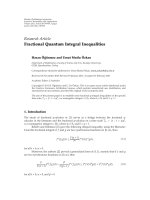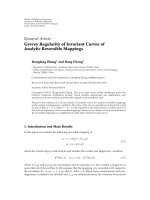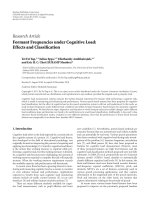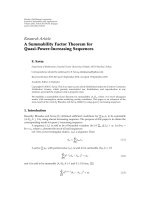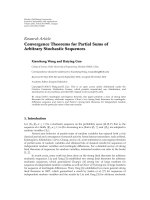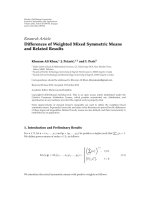Báo cáo hóa học: "Research Article 2-D DOA Estimation via Matrix Partition and Stacking Technique" pdf
Bạn đang xem bản rút gọn của tài liệu. Xem và tải ngay bản đầy đủ của tài liệu tại đây (1010.95 KB, 8 trang )
Hindawi Publishing Corporation
EURASIP Journal on Advances in Signal Processing
Volume 2009, Article ID 896284, 8 pages
doi:10.1155/2009/896284
Research Article
2-D DOA Estimation via Matrix Partition and Stacking Technique
Nan-Jun Li, Jian-Feng Gu, and Ping Wei
Department of Electronic Engineering, University of Electronic Science and Technology of China, Chengdu, Sichuan 610054, China
Correspondence should be addressed to Jian-Feng Gu, and Ping Wei,
Received 26 February 2009; Revised 14 June 2009; Accepted 31 August 2009
Recommended by M. Greco
A novel approach is proposed for the efficient estimation of the two-dimensional (2-D) direction-of-arrival (DOA) of signals
impinging on two orthogonal uniform linear arrays (ULAs). By partitioning the cross-correlation matrix (CCM) between two
ULAs data into a great deal ofsubmatrices and making use of the submatrices and the symmetric subarrays, an extended correlation
matrix is constructed, and then uses the modified ESPRIT approach to extract out the so-called Kronecker Steering Vectors
(KSVs)of which each is the Kronecker product of the elevation and azimuth angle with a one-to-one relationship. Upon that
the proposed method yields the estimate of the 2-D DOA efficiently without requiring the additionally computational burden
to remove the pair-matching problem. Furthermore, the main idea of the matrix partition and stacking is to much-enhanced
subspace estimate. So based on the use of the concept, the proposed method’s performance is better than the existing similar
approaches. Meanwhile, unlike the traditional subspace methods, it is shown that the proposed can resolve the same uncorrelated
sources as the number of subarray sensor through a delicate partition-and-stacking process. Simulation results demonstrate that
the proposed method is superior to the existing techniques in both DOA estimation and the detection capability of sources.
Copyright © 2009 Nan-Jun Li et al. This is an open access article distributed under the Creative Commons Attribution License,
which permits unrestricted use, distribution, and reproduction in any medium, provided the original work is properly cited.
1. Introduction
The problem of two-dimensional (2-D) DOA (i.e., azimuth
and elevation angles) has recently received increasing atten-
tion. 2-D DOA problem may be closer to some practical
environment than 1-D, for instance, using an airborne
or a spaceborne array to observe ground-based sources.
Additionally, in the last three decades a number of the high-
resolution direction finding methods [1] have been studied
in the context of 1-D estimation (e.g., the azimuth angle)
of multiple plane waves. Among them, MUSIC (Multiple
Signal Classification) [2]andESPRIT[3] are considered the
two most popular algorithms. Many 2-D DOA methods are
based on the two algorithms. Specially, the latter method
has two main advantages over the former. First, the ESPRIT
algorithm requires less computational burden and storage
space due to that it does not require to search over the
whole parameter space. Second, independent of the array
response, the ESPRIT algorithm is more robust to array
calibration errors. Therefore, the ESPRIT algorithm and its
variations [4, 5], which are widely devoted to the problem
of 2-D DOA estimation with planar arrays, have received
considerable attention in the array-processing literature [6–
13]. Majority of the planar arrays required to implement()
these techniques can be divided into three types: the two-
orthogonal uniform linear array (the L-shaped array) [6–9],
the triangular array [10, 11], and the rectangular array [12,
13]. Although the L-shaped array has a simpler configuration
compared to the rectangular and triangular ones, it enjoys
higher accuracy among these configurations [6]. Thus the L-
shaped array has received increased attention in dealing with
2-D DOA estimation problems recently.
In [9], Tayem and Kwon presented a computationally
simple 2-D DOA estimation with the propagator method
using one or two L-shaped arrays. They showed that
it is possible to decompose the 2-D problem into two
independent 1-D problems by using the L-shape array for
reducing the computational burden significantly. But the two
independent sets of angles would have to be properly paired
together using some technique [14]. Different approaches
have been put forward in the literature. For example, Kikuchi
et al. [15] describe a cross-correlation technique obtaining
the correct parameter pairs by constructing a Toeplitz matrix
whose first column and row are the diagonal elements
2 EURASIP Journal on Advances in Signal Processing
of the CCM and its conjugate transpose including the
relation between the corresponding combinations of the
elevation and azimuth angles. Unfortunately, the Kikuchi’s
approach still causes the pair-matching problem when the
difference of the corresponding combinations of the 2-D
angles
{cos θ
k
−cos φ
k
}
K
k
=1
is small and the signal-to-noise
ratio (SNR) is low [8]. Furthermore, it only employs the
CCM to deal with the pair-matching problem such as the
pairing algorithm suggested in [9], but does not exploit
its characteristics to improve the estimation performance.
Recently, Gu and Wei [8] described a technique which
utilized joint singular value decomposition (JSVD) for two
submatrices selected from CCM unaffected by the additive
noise on the condition because of the reasonable assumption
for noise and signal to achieve automatic pairing and
estimate 2-D DOA. In this way, the JSVD technique in [8]
takes at least two advantages over the technique suggested
in [15]. First, it has been shown that the JSVD technique
does not need additional steps to deal with the pair matching
problem. Second, the JSVD is superior in estimating the 2-
D DOA, especially at low SNR and with a small number of
snapshots.
Therefore, the objective of this paper is to develop
another technique for 2-D DOA estimation of multiple
sources from two orthogonal ULAs (L-shape array) by
partition and stacking the CCM between two ULAs, showing
new aspects associated to it. It is unlike the algorithm
proposed in [8]. The authors divided the CCM into two
submatrices. Herein we will partition the CCM into more
submatrices and stack them to form an extended correlation
matrix. The extended matrix is formed by taking full
advantage of the structure in the underlying data models to
apply the modified ESPRIT approach to efficiently obtain
the KSVs containing the one-to-one information of the
azimuth and elevation angles. The 2-D DOAs automatically
paired are then found one-by-one by decomposing the
KSVs. Actually, not only ESPRIT but also MUSIC or other
methods can be modified to process the extended matrix.
However, according to the ESPRIT advantages mentioned
above, we modify ESPRIT to process here. Finally, through
extensive simulations, it can be demonstrated that the
proposed technique overcomes the problems encountered
in the Kikuchi method and offers improved estimation
performance as well.
The organization of this paper is as follows: We formulate
the problem in Section 2.InSection 3, the 2-D DOA
estimator is proposed. Experimental results are provided in
Section 4 to demonstrate the performance of the proposed
technique. Finally, some conclusions are given in Section 5.
2. Problem Formulation
The algorithm presented in this paper applies to sensor arrays
with two orthogonally ULAs. For simplicity of presentation,
we focus our derivation on an L-shape array of sensors.
Consider two ULAs with inter-element spacing d, making
up of the L-shape array configuration in the x
− z plane as
shown in Figure 1. Each linear array consists of M sensor
φ
k
θ
k
s
k
(t)
Z
M
.
.
.
2
Y
X
M
.
.
.
1
1
Figure 1: Array elements configuration for the joint elevation and
azimuth DOA estimation [8].
elements and the element placed at the origin belongs to
the z-axis. Suppose that there are K narrowband sources
with wavelength λ impinging on the array from different
directions, where the number of sources K is known or pre-
estimated using some detection techniques (e.g., [16, 17]and
references therein). The kth source has an elevation angle θ
k
and an azimuth angle φ
k
. These sources are assumed to be in
the far-field with respect to the sensor location. The observed
signals at the ULA along the x-axis and the ULA along the z-
axis are given, respectively, by
x
(
t
)
= A
x
s
(
t
)
+ n
x
(
t
)
,
z
(
t
)
= A
z
s
(
t
)
+ n
z
(
t
)
.
(1)
The matrices and vectors in (1) have the follow-
ing definitions. Both of the observed signals z(t)
=
[z
1
(t), z
2
(t), , z
M
(t)]
T
and x(t) = [x
1
(t), x
2
(t), , x
M
(t)]
T
are M × 1 vectors and functions of the snapshot t.The
superscript Tdenotes the transpose. The source vector s(t)
=
[s
1
(t), s
2
(t), , s
K
(t)]
T
is a K × 1 vector. It is also assumed
that these Ksources are uncorrelated with each other and the
additive noises
{n
z
(t), n
x
(t)} are independent of the signal
samples [8, 15, 18]. The elements of
{n
z
(t), n
x
(t)} are white
Guassian random processes with zero-mean and variance σ
2
:
A
z
=
[
a
(
θ
1
)
, a
(
θ
2
)
, ,a
(
θ
K
)
]
,
A
x
=
a
φ
1
, a
φ
2
, ,a
φ
K
,
(2)
are the M
×K array response matrices in the x subarray and
z subarray, respectively. The response vectors in the elevation
and azimuth directions are expressed as
a
(
θ
k
)
=
1, e
−jα
k
, ,e
−j
(
M−1
)
α
k
T
,
a
φ
k
=
1, e
−jβ
k
, ,e
−j
(
M−1
)
β
k
T
,
(3)
where α
k
= 2πd cos θ
k
/λ and β
k
= 2πd cos φ
k
/λ.
Remark A. Although the assumptions above on the additive
noises are the spatial white to consistent with those of
Kikuchi’s, but our method is less strict to the spatial
EURASIP Journal on Advances in Signal Processing 3
correlation of the noise due to the fact that our method
makes use of the CCM between the the different ULA,
where the additive noise can be eliminated. Additionally,
it is necessary for the Kikuchi’s method to assume the
same number of sensors in the different ULA, while our
method has not the limitation if only both of them are
greater than or equal to the number of incident signals
due to the fact that our method makes use of the many
submatrices selected from the CCM. Therefore, compared to
the Kikuchi’s method our method is more flexible to design
the array configuration.
3. Proposed Method
Under the assumptions of data model, we easily get a cross-
correlation matrix R
xz
between the signal vectors x(t)and
z(t) described in [8]:
R
xz
= E
x
(
t
)
z
H
(
t
)
=
A
x
E
s
(
t
)
s
H
(
t
)
A
H
z
+ E
n
x
(
t
)
n
H
z
(
t
)
=
A
x
ΛA
H
z
,
(4)
where Λ
= diag{ρ
1
, ,ρ
K
} and ρ
k
is the power of the
kth source, and E
{•} denotes the statistical expectation. The
superscript Tdenotes the conjugate transpose. It is easy to see
that the cross-correlation matrix R
xz
is not affected by the
additive noise because of the assumptions mentioned above.
Now we introduce our proposed method.
3.1. Partition and Stacking Processing. Let us define a selec-
tion matrix of dimension p
×M as follows:
P
i
=
0
p×
(
i
−1
)
I
p
0
p×
(
M−p−i+1
)
, i = 1, , M − p +1, (5)
where 0
a×b
isazeromatrixofsizea × b and I
p
an identity
matrix of dimension p. It is well known that the M
×Mmatrix
R
xz
can be divided into (M −p+1)
2
overlapping submatrices
of dimension p
× p. The corresponding submatrix R
i,j
are,
hence, defined as follows:
R
i,j
P
i
{R
xz
}P
T
j
= P
i
A
x
Λ
P
j
A
z
H
A
xi
ΛA
H
zj
, i, j = 1, , M − p +1,
(6)
where A
ab
is the bth row to the (b + p − 1)th row of A
a
(a =
x, z). According to the ULA assumption, we can get the
relationship A
ab
= A
a1
Ω
i−1
a
, where the matrix Ω
i−1
a
denotes
the (i
− 1)th power of a K × K diagonal matrix along the
a-axis Ω
a
= diag(γ
a,1
, ,γ
a,K
)and
γ
a,k
=
⎧
⎨
⎩
exp
−
jα
k
a = z,
exp
−
jβ
k
a = x,
k
= 1, , K. (7)
Therefore, (6)canbewrittenas
R
i,j
= A
x1
Ω
i−1
x
ΛΩ
1−j
z
A
H
z1
= A
x1
Ω
1−j
z
ΛΩ
i−1
x
A
H
z1
.
(8)
Next, we can obtain a stacking matrix R of size p(M
−p+
1)
× p(M − p +1):
R
=
R
1
, ,R
M−p+1
,(9)
where
R
i
=
R
T
i,1
, ,R
T
i,M
−p+1
T
=
⎡
⎢
⎢
⎢
⎢
⎢
⎢
⎢
⎣
A
x1
A
x1
Ω
−1
z
.
.
.
A
x1
Ω
−(M−p)
z
⎤
⎥
⎥
⎥
⎥
⎥
⎥
⎥
⎦
ΛΩ
i−1
x
A
H
z1
, i = 1, , M − p +1.
(10)
Remark B. In order to avoid the effect of additive noise, the
auto-correlation matrices of the submatrices are not used
in the computation of the stacking matrix in (10), which
contains all information of the elevation and azimuth angles.
The methods in [7, 9, 15] exploit only the auto-correlation
matrices to estimate the elevation and azimuth angle in each
ULA along the z and x axis, respectively, and the CCM
between different ULA is only employed to obtain the pair-
matching information described in [7, 9].
Then, rewrite (9) in explicit form by take full advantage
of array structural information:
R
=
⎡
⎢
⎢
⎢
⎢
⎢
⎢
⎢
⎣
A
x1
A
x1
Ω
−1
z
.
.
.
A
x1
Ω
−(M−p)
z
⎤
⎥
⎥
⎥
⎥
⎥
⎥
⎥
⎦
Λ
A
H
z1
, Ω
−1
x
A
H
z1
, ,Ω
−(M−p)
x
A
H
z1
=
⎡
⎢
⎢
⎢
⎢
⎢
⎢
⎢
⎣
A
x1
A
x1
Ω
−1
z
.
.
.
A
x1
Ω
−(M−p)
z
⎤
⎥
⎥
⎥
⎥
⎥
⎥
⎥
⎦
Λ
⎡
⎢
⎢
⎢
⎢
⎢
⎢
⎢
⎣
A
z1
A
z1
Ω
−1
x
.
.
.
A
z1
Ω
−(M−p)
x
⎤
⎥
⎥
⎥
⎥
⎥
⎥
⎥
⎦
H
=
B
c
z
◦A
x1
Λ
B
c
x
◦A
z1
H
,
(11)
where the superscript c denotes the complex conjugate and
◦
is the Khatri-Rao matrix product defined by B ◦ A [b
1
⊗
a
1
, b
2
⊗ a
2
, ,b
K
⊗ a
K
]where⊗ is the Kronecker Product
[19], and
B
x
= A
x
with the last p rows deleted,
B
z
= A
z
with the last p rows deleted.
(12)
4 EURASIP Journal on Advances in Signal Processing
Then, we can write the stacking matrix R as
R
=
b
c
(
θ
1
)
⊗a
1
φ
1
, b
c
(
θ
2
)
⊗a
1
φ
2
, ,b
c
(
θ
K
)
⊗a
1
φ
K
Λ
·
b
c
φ
1
⊗
a
1
(
θ
1
)
, b
c
φ
2
⊗
a
1
(
θ
2
)
, ,b
c
φ
K
⊗
a
1
(
θ
K
)
H
d
1
θ
1
, φ
1
, d
1
θ
2
, φ
2
, ,d
1
θ
K
, φ
K
Λ
·
d
2
(θ
1
, φ
1
), d
2
(θ
2
, φ
2
), ,d
2
(θ
K
, φ
K
)
H
D
1
θ, φ
ΛD
H
2
θ, φ
,
(13)
where b(θ
k
)andb(φ
k
) are the first (M − p) elements of
a(θ
k
)anda(φ
k
), respectively. d
i
(θ
k
, φ
k
)(i = 1, 2, k =
1, ,K)isdefinedasthekth Kronecker Steering Vector
(KSV) containing the kth one-to-one elevation and azimuth
angle information of the ith combination. It can be verified
[18] that D
1
(θ, φ)andD
2
(θ, φ) are full column rank if
min
{p(M − p +1),M +1} >K. It is worth noting that our
method can detect M signals when p(M
− p +1)≥ M +1.
Hence, R is of rank K.
Asthearraygeometrymentionedearlier,A
x
and A
z
have
the following relationship:
A
x
= J
M
A
c
x
Ω
M
x
, A
z
= J
M
A
c
z
Ω
M
z
, (14)
where J
M
is the “reversal identity matrix” obtained by
reversing the order of the rows of I
M
.
Now, recall (4)anduse(14)toobtain
JR
xz
JR
c
xz
J
T
= JA
c
x
ΛA
T
z
J = A
x
Ω
−M
x
ΛΩ
M
z
A
H
z
A
x
ΠA
H
z
.
(15)
It is easy to find that Π
= Ω
−M
x
ΛΩ
M
z
is also a diagonal matrix.
Hence, we can construct another stacking matrix following
the same steps as (6)–(13)
JR
= D
1
θ, φ
ΠD
H
2
θ, φ
. (16)
Due to the similarity between R and JR, it can be similarly
shown that rank of JR is K if M +1>K.
3.2. Estimating 2-D DOA. From (13)and(16), we can
see that R and JR are constructed from the same KSVs
and the different diagonal matrices (i.e., Λ and Π). The
authors of [8] proposed a new scheme to extract the signal
subspace by the joint singular value decomposition of the
two concatenated matrices with the same left or right
singular vectors. Inspired by the idea mentioned above,
herein we also exploit the JSVD-based to obtain the KSVs.
In the Appendix, we show how the KSVs are estimated from
(13)and(16) using the ESPRIT-like algorithm. Note that
unlike the standard ESPRIT extracting the signal subspace
from the eigendecomposition of the covariance matrix of
the concatenated measurements from the main array and its
copy, here the KSVs are obtained by the JSVD of (13)and
(16). In this way, we can detect the same number of signals
as sensors, while the standard ESPRIT will not work in this
case.
Having obtained the estimated KSVs
D,wecanestimate
the 2-D DOA of each signal. Obviously, we can implement
it by the 2-D “beamforming-like” technique, but searching
over 2-D parameter space is a hard work. Therefore, we
will suggest the following simple arithmetic to obtain the
elevation and azimuth angles, and the kth elevation angle can
be got
θ
k
= cos
−1
⎡
⎢
⎢
⎣
arg
D
p +1: p
M − p +1
, k
H
A
2πd/λ
⎤
⎥
⎥
⎦
(17)
where A denotes
D(1 : p(M − p), k)and
D(a : b, k)denotes
the ath to bth elements of the kth column of
D.Inorder
to obtain the corresponding azimuth angle, herein defines a
permutation matrix by
Γ
=
I
M−p
⊗e
1
, I
M−p
⊗e
2
, ,I
M−p
⊗e
p
, (18)
where e
i
is the ith column of I
p
, we then have
D
= Γ
D
=
a
1
φ
1
⊗
b
c
(
θ
1
)
, a
1
φ
2
⊗
b
c
(
θ
2
)
, ,a
1
φ
K
⊗
b
c
(
θ
K
)
Q
(19)
φ
k
= cos
−1
⎡
⎣
arg
D
1:
p −1
M − p +1
, k
H
B
2πd/λ
⎤
⎦
(20)
where B denotes
D(M − p +2: p(M − p +1),k).
Remark C. Thepairingprocedureof[15] is implemented
by making good use of the diagonal elements of the
cross-correlation matrix between different ULA embodying
the corresponding pairs information of the elevation and
azimuth angles. However, we find that the parameters with
the pair-matching information are ω
k
= cos θ
k
− cos φ
k
k =
1, ,K. Therefore, it is easily verify when the difference
among the parameters is very small or there is the same
elevation (azimuth) angles and the azimuth (elevation) angle
are very close, the Toeplitz matrix formed by the diagonal
elements of the cross-correlation matrix may be a rank-
deficient matrix so as not to obtain the correct pairing
information for the elevation and azimuth angles [9] Like
the method in [8], our proposed can also remove these
problems completely by the process of estimating every
DOAs independently.
3.3. The Proposed Algorithm. In summary, the proposed
source estimation method with finite array data can be
implemented as follows.
EURASIP Journal on Advances in Signal Processing 5
2520151050−5
SNR (dB)
p
= 2
p
= 3
p
= 4
10
−2
10
−1
10
0
10
1
RMSE (deg)
(a)
2520151050−5
SNR (dB)
p
= 2
p
= 3
p
= 4
10
−2
10
−1
10
0
10
1
RMSE (deg)
(b)
Figure 2: RMSE of 2-D DOA estimation from (55
◦
, 100
◦
) for (a) elevation and (b) azimuth angle.
(1) Calculate the estimated CCM and its reversal version
between the received signal data x(t)andz(t)t
=
1, ,N:
R
xz
=
1
N
N
t=1
x
(
t
)
z
H
(
t
)
JR
xz
J
R
c
xz
J
T
(21)
(2) Form an 2p(M
−p+1)×p(M−p+1) extended matrix
R
E
by stacking the estimated CCM as
R
E
R
JR
.
(3) Perform SVD of
R
E
. Keep the first 2p(M −p +1)×K
submatrix of the left singular vectors of
R
E
. Let this
submatrix be
U
1
divided into two matrices
U
11
and
U
12
of dimension p(M − p +1)×K as in (A.3).
(4) Estimate the KSV matrices
D in (A.6)and
D in (19),
which obtain the K KSVs with one-to-one elevation
and azimuth angles information.
(5) Estimate the kth 2-D angle
{θ
k
, φ
k
} by implementing
the kth KSV from (17)and(20). Note that 2-D angles
are paired up automatically without extra association
needed herein.
4. Simulation Results
In this section, we compare the estimation performance
of the proposed method in estimating the 2-D DOAs and
the detection probability of successful pair matching. We
consider each ULA with elements spaced λ/2apartand
M
= 5 sensors. Monte Carlo simulations based on 1000
independent realizations of the received data were carried
out.
In the first test, we examine the DOA performance of two
uncorrelated sources with equal power. Submatrices of size
p
= 2, 3,4 are chosen. The incident directions of sources are
[θ
1
, φ
1
] = [45
◦
, 110
◦
]and[θ
2
, φ
2
] = [55
◦
, 100
◦
], the number
of snapshots is 200, and SNR varies from –5 to 25 dB. The
objective performance measure is the root mean square error
(RMSE) defined as
RMSE
=
1
T
T
t=1
∧
a
(
t
)
−a
2
, a = θ, φ, (22)
where T is the number of the independent trials. Figure 2
shows the RMSE of one of DOA [θ
2
, φ
2
] = [55
◦
, 100
◦
]
estimation versus SNR for different subarray sizes by the
proposed method. It can be seen from Figure 2 that RMSE
of the elevation (azimuth) angle increases (decreases) with
the increasing size of the submatrices. This is mainly due
to the fact that the larger the number of dimensions to
construct the KSV matrix, the better the alleviation of the
noise by SVD to obtain the KSV matrix. Therefore, we will
use the proposed method with the submatrix size of 3 in the
subsequent experiments because of the largest dimensions.
Performance evaluation of the proposed method, the
CCM method based on ESPRIT (CCM-ESPRIT) [15],
MUSIC [2] and the joint SVD (JSVD) in [8]isconducted
along with the Cramer-Rao bound (CRB) [20]. The signals
considered herein are the same as those in the first experi-
ment.
To comprehensive comparison of performance of the 2-D
DOA estimation, another objective criterion so-called joint
6 EURASIP Journal on Advances in Signal Processing
2520151050
SNR (dB)
CCM-ESPRIT
JSVD in [8]
Proposed
MUSIC
CRB
0
0.5
1
1.5
2
2.5
3
3.5
4
4.5
5
RMSE (deg)
(a)
2520151050
SNR (dB)
CCM-ESPRIT
JSVD in [8]
Proposed
MUSIC
CRB
0
0.5
1
1.5
2
2.5
3
3.5
4
4.5
5
RMSE (deg)
(b)
Figure 3: JRMSE of joint elevation and azimuth angle estimation versus SNR for two uncorrelated sources with equal power at the DOA:
(a) (45
◦
, 110
◦
)and(b)(55
◦
, 100
◦
).
10
3
10
2
10
1
Snapshot (N)
CCM-ESPRIT
JSVD in [8]
Proposed
MUSIC
CRB
0
0.5
1
1.5
2
2.5
3
3.5
4
RMSE (deg)
(a)
10
3
10
2
10
1
Snapshot (N)
CCM-ESPRIT
JSVD in [8]
Proposed
MUSIC
CRB
0
0.5
1
1.5
2
2.5
3
3.5
4
RMSE (deg)
(b)
Figure 4: JRMSE of joint elevation and azimuth angle estimation versus the number of snapshots for two uncorrelated sources with equal
power at the DOA: (a) (45
◦
, 110
◦
)and(b)(55
◦
, 100
◦
).
of root mean square error (JRMSE) defined as
JRMSE
=
1
T
T
t=1
⎡
⎣
∧
θ
(
t
)
−θ
2
+
∧
φ
(
t
)
−φ
2
⎤
⎦
(23)
JRMSEs of the estimated elevation and azimuth angles versus
SNR and the number of snapshots are plotted in Figures
3 and 4, respectively. Results of Figure 4 are produced at
SNR
= 10 dB. We observe that the proposed method delivers
the most accurate DOA estimates among four methods,
especially at low SNR. Similar results are obtained for smaller
EURASIP Journal on Advances in Signal Processing 7
86420−2−4−6−8−10
SNR (dB)
Proposed
JSVD in [8]
CCM-ESPRIT
0
0.2
0.4
0.6
0.8
1
Detection probability
Figure 5: Detection probability verses SNR for two uncorrelated
sources with equal power.
number of snapshots. This may be due to the fact that the
CCM-ESPRIT method only uses the CCM to overcome the
pair-matching problems, but not for the DOA estimation,
and though the JSVD method exploited the CCM to improve
the estimation performance significantly, our technique
makes good use of the structure of the CCM to make up
the extended matrix with higher dimension for eliminating
the effect of additive noise further. Performance of these
methods at SNR higher than 10 dB is about the same and
close to the CRB.
We also assess the estimation performance in terms of
the detection probability of successful pair matching, as
shown in Figure 5. The results indicate that the proposed
method exhibits the similar detection rates to JSVD and
higher detection rates than CCM-ESPRIT. It is worth noting
that the CCM-ESPRIT method exhibits very low detection
rate at low SNR. This phenomenon may be due to the fact
that the Toeplitz matrix used in CCM-ESPRIT [15]toget
pair-matching while the proposed and JSVD in [8] are paired
automatically.
Figure 6 shows the scatter plots of the elevation angle
versus the azimuth angle for 2-D DOA estimation of
five equal power uncorrelated signals from the direc-
tion [(5
◦
140
◦
), (15
◦
130
◦
), (30
◦
120
◦
), (40
◦
100
◦
), (50
◦
90
◦
)]. It
is observed that the proposed method is able to deal with
more sources than CCM-ESPRIT and JSVD which can
estimate four signals at best, that is, the estimates of five
signals approach to their respective true values as shown in
Figure 6.
5. Conclusions
In this paper, we have presented a new automatic pairing
method for 2-D DOA Algorithm using two orthogonal
1601501401301201101009080
Azimuth angle (deg)
Proposed method for five signals
0
10
20
30
40
50
60
70
80
Elevation angle (deg)
Figure 6: Scatter plot of the elevation angle versus the azimuth
angle for 2-D DOA estimation of five equal power signals at
[(5
◦
, 140
◦
),(15
◦
, 130
◦
),(30
◦
, 120
◦
),(40
◦
, 100
◦
),(50
◦
,90
◦
)] with 30 dB
and 500 snapshots.
ULAs. The proposed method obtains an extended matrix
by partition and stacking the CCM, and then estimates the
KSVs with pair-matching information to get the one-to-
one elevation and azimuth angles. In addition, because of
the matrix structural rearrangement, more array structural
information are utilized to improve the performance of
the DOA estimation. Simulation results have demonstrated
that the proposed scheme not only provides more accurate
estimates than the CCM-ESPRIT and JSVD, especially at low
SNR, but also works well when sources equal to sensors of
ULA.
Appendix
Obtaining the Kronecker Steering Vectors
Defineanextendedmatrixofsize2p(M−p+1)×p(M−p+1)
by concatenating R, JR as
R
E
⎡
⎣
R
JR
⎤
⎦
=
⎡
⎣
D
1
θ, φ
Λ
D
1
θ, φ
Π
⎤
⎦
D
H
2
θ, φ
. (A.1)
The singular value decomposition of the matrix R
E
yields
R
E
=
[
U
1
U
2
]
⎡
⎣
Σ 0
00
⎤
⎦
V
H
,(A.2)
where Σ
= diag(σ
1
, ,σ
K
)andU
1
= [u
1
, ,u
K
]U
2
=
[u
zK+1
, ,u
z2p(M−p+1)
]. Combining (13)and(16)with
(A.1)-(A.2), it can be easily proven [8] that there exists a
nonsingular K
×K matrix T such that
U
1
⎡
⎣
U
11
U
12
⎤
⎦
=
⎡
⎣
D
1
θ, φ
D
1
θ, φ
Ω
xz
⎤
⎦
T,(A.3)
8 EURASIP Journal on Advances in Signal Processing
where U
11
and U
12
denote the first and last p(M −p+1)rows
of U
1
,andΩ
xz
Ω
−M
x
Ω
M
z
has been used. It then follows that
U
†
11
U
12
= T
−1
Ω
xz
T,(A.4)
where the “
†
” denote the pseudo-inverse. By eigendecompos-
ing, we obtain
U
†
11
U
12
= EΛ
xz
E
−1
,(A.5)
where E and Λ
xz
are the eigenvector matrix and the asso-
ciated eigenvalue matrix of U
†
11
U
12
. A comparison of (A.5)
and (A.4) follows that E
= T
−1
Q,whereQ is a “generalized”
permutation matrix, and Ω
xz
= QΛ
xz
Q
−1
. Note that
the detailed definition of the “generalized” permutation
matrix can be found in [21]. Here we will quote it to
prevent repetition of work directly. Therefore, recall (A.3),
an improved estimate of D
1
(θ, φ) can be obtained by
D = D
1
θ, φ
Q =
1
2
(
U
11
E + U
12
EΛ
xz
)
. (A.6)
Acknowledgments
The authors would like to thank the anonymous reviewers
for their useful comments and suggestions. This work is
partially supported by the Program for New Century Excel-
lent Talents in University (NCET), Ministry of Education,
China. J. F. Gu is supported by China Postdoctoral Science
Foundation (20080441199).
References
[1] H. Krim and M. Viberg, “Two decades of array signal
processing research: the parametric approach,” IEEE Signal
Processing Magazine, vol. 13, no. 4, pp. 67–94, 1996.
[2] R. O. Schmidt, “Multiple emitter location and signal param-
eter estimation,” IEEE Transactions on Antennas and Propaga-
tion, vol. 34, no. 3, pp. 276–280, 1986.
[3] R. Roy and T. Kailath, “ESPRIT—estimation of signal param-
eters via rotational invariance techniques,” IEEE Transactions
on Acoustics, Speech, and Signal Processing, vol. 37, pp. 984–
995, 1989.
[4] Y. Hua and T. K. Sarkar, “On SVD for estimating generalized
eigenvalues of singular matrix pencil in noise,” IEEE Transac-
tionsonSignalProcessing, vol. 39, no. 4, pp. 892–900, 1991.
[5] M. D. Zoltowski and D. Stavrinides, “Sensor array signal
processing via a procrustes rotations based eigenanalysis of the
ESPRIT data pencil,” IEEE Transactions on Acoustics, Speech,
and Signal Processing, vol. 37, no. 6, pp. 832–861, 1989.
[6] Y.Hua,T.K.Sarkar,andD.D.Weiner,“AnL-shapedarrayfor
estimating 2-D directions of wave arrival,” IEEE Transactions
on Antennas and Propagation, vol. 39, no. 2, pp. 143–146, 1991.
[7] N. Tayem and H. M. Kwon, “L-shape 2-dimensional arrival
angle estimation with propagator method,” IEEE Transactions
on Antennas and Propagation, vol. 53, no. 5, pp. 1622–1630,
2005.
[8] J. F. Gu and P. Wei, “Joint SVD of two cross-correlation
matrices to achieve automatic pairing in 2-D angle estimation
problems,” IEEE Antennas and Wireless Propagation Letters,
vol. 6, pp. 553–556, 2007.
[9] L. Bai, C Y. Peng, and S. Biswas, “Association of DOA estima-
tion from two ULAs,” IEEE Transactions on Instrumentation
and Measurement, vol. 57, no. 6, pp. 1094–1101, 2008.
[10]A.J.vanderVeen,P.B.Ober,andE.F.Deprettere,
“Azimuth and elevation computation in high resolution DOA
estimation,” IEEE Transactions on Signal Processing, vol. 40, no.
7, pp. 1828–1832, 1992.
[11] V. S. Kedia and B. Chandna, “A new algorithm for 2-D DOA
estimation,” Signal Processing, vol. 60, no. 3, pp. 325–332,
1997.
[12] A. L. Swindlehurst and T. Kailath, “Azimuth/elevation direc-
tion finding using regular array geometries,” IEEE Transactions
on Aerospace and Electronic Systems, vol. 29, no. 1, pp. 145–156,
1993.
[13] P. Strobach, “Two-dimensional equirotational stack subspace
fitting with an application to uniform rectangular arrays and
ESPRIT,” IEEE Transactions on Signal Processing, vol. 48, no. 7,
pp. 1902–1914, 2000.
[14] T. Shu, X. Liu, and J. Lu, “Comments on “L-shape
2-dimensional arrival angle estimation with propagator
method”,” IEEE Transactions on Antennas and Propagation, vol.
56, no. 5, pp. 1502–1503, 2008.
[15] S. Kikuchi, H. Tsuji, and A. Sano, “Pair-matching method
for estimating 2-D angle of arrival with a cross-correlation
matrix,” IEEE Antennas and Wireless Propagation Letters, vol.
5, no. 1, pp. 35–40, 2006.
[16] J. Xin, N. Zheng, and A. Sano, “Simple and efficient nonpara-
metric method for estimating the number of signals without
eigendecomposition,” IEEE Transactions on Signal Processing,
vol. 55, no. 4, pp. 1405–1420, 2007.
[17] P. Stoica and Y. Sel
´
en, “A review of information criterion
rules,” IEEE Signal Processing Magazine, vol. 21, no. 4, pp. 36–
47, 2004.
[18] M. Jansson, B. G
¨
oransson, and B. Ottersten, “A subspace
method for direction of arrival estimation of uncorrelated
emitter signals,”
IEEE Transactions on Signal Processing, vol. 47,
no. 4, pp. 945–956, 1999.
[19] J. W. Brewer, “Kronecker products and matrix calculus in
system theory,” IEEE Transactions on Circuits and Systems, vol.
25, no. 9, pp. 772–781, 1978.
[20]P.StoicaandA.Nehorai,“Music,maximumlikelihood,and
Cramer-Rao bound,” IEEE Transactions on Acoustics, Speech,
and Signal Processing, vol. 37, no. 5, pp. 720–741, 1989.
[21] Y. Hua and K. Abed-Meraim, “Techniques of eigenvalues
estimation and association,” DigitalSignalProcessing, vol. 7,
no. 4, pp. 253–259, 1997.
